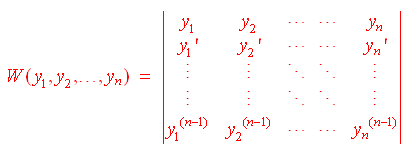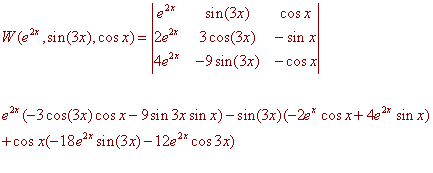Higher Order Differential Equations
Recall that the order of a differential equation is the highest derivative that appears in the equation. So far we have studied first and second order differential equations. Now we will embark on the analysis of higher order differential equations. We will restrict our attention to linear differential equations. The general linear differential equation can be written as
dny
dn-1y
dy
L(y) =
+ p1(t)
+ . . . + pn-1(t)
+ pn(t)y = g(t)
dt
dt
dt
The good news is that all the results from second order linear differential equation can be extended to higher order linear differential equations. We list without proof the results
- If p1, ... pn
are continuous on an interval
[a,b] then there is a unique solution to the
initial value problem, where instead of the initial conditions
y(0) = y0 and y'(0)
= y'0 , we need the initial
conditions
y(0) = y0 , y'(0) = y'0, y''(0) = y''0, ... , y(n-1)(0) = y(n-1)0
- L(y) is a linear
transformation, that is
L(c1y1+ x2y2 + ... + cnyn) = c1L(y1) + c2L(y2) + ... + cnL(yn)
- If y1, y2 ... yn
are solutions to L(y)
= 0, then c1y1+
x2y2 + ... + cnyn
is also a solution.
- For differentiable functions y1,
y2 ... yn, we define the Wronskian
by

- Differentiable functions
y1, y2 ... yn are
linearly independent if the Wronskian is
nonzero for some t in
[a,b].
- L(y) = 0
has n linearly
independent solutions.
- If yh is
the general solution to L(y) = 0
and if yp
is a particular solution to L(y) =
g(t), then yh
+ yp is the general solution to L(y)
= g(t).
- Abel's theorem
still holds. That is, if y1, y2
... yn are linearly independent
solutions of L(y) = 0,
then

- The method of reduction of order still works. If y1 is a solution to L(y1) = 0, then L(v1y1) can be reduced to a differential equation of degree n - 1.
Example
Determine if the following functions are linearly independent
y1 = e2x y2 = sin(3x) y3 = cos x
Solution
First take derivatives
y'1 = 2e2x y'2 = 3cos(3x) y'3 = -sin x
y''1 = 4e2x y''2 = 9sin(3x) y''3 = -cos x
The Wronskian is

Now plug in x = 0 (or any other value for x) to get
(1)(-3 - 0) - (0)(-2 + 0) + (1)(0 - 12) = -15
In particular, since this is a nonzero number, we can conclude that the three functions are linearly independent.
Example
Use Abel's theorem to find the Wronskian of the differential equation
ty(iv) + 2 y''' - tety'' + (t3 - 4t)y' + t2sin ty = 0
Solution
We first divide by t to get
y(iv) + 2/t y''' - ety'' + (t2 - 4)y' + t sin t y = 0
Now take the integral of 2/t to get
2ln t
The Wronskian is thus
c e2ln t = c t2
Back to the Application and Higher Order Equations Home Page
Back to the Differential Equations Home Page
Back to the Math Department Home Page
e-mail Questions and Suggestions